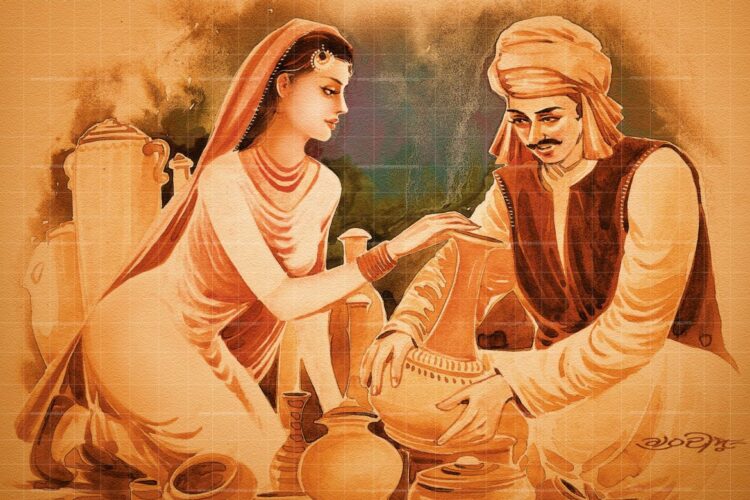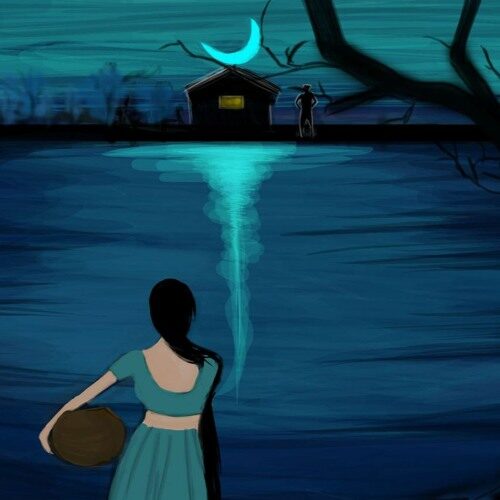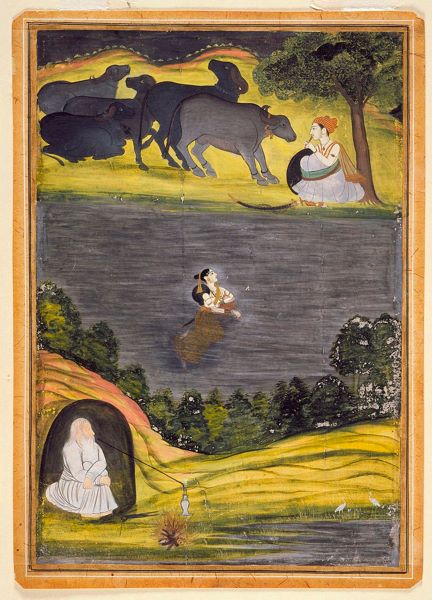Story of Sohni Mahiwal
Romantic Tragic Folk Tale
 Sohni Mahiwal Painting
Sohni Mahiwal PaintingSohni Mahiwal is a tragic romance folk tale which is said to have occurred in the 18th century in the Punjab, near Chenab river in Pakistan.
It has been passed down to the next generations through oral traditions, poetry, and songs.
Traditions, culture and folk tales normally get transferred without any documented references.
So is the case with many anecdotes, quotes, advices and experiences which are passed down from generation to generation.
Like Romeo and Juliet, the tale of Sohni Mahiwal has become synonymous with eternal, sacrificial love.
Before We Start With The Story of Sohni Mahiwal ...
Please note that the folk tale of Sohni Mahiwal may not be hundred percent true nor historical.
It is a folk and a mythical tale which may also have many more versions of being true and untrue.
The exact details may not be acquired due to limited historical data.
At the same time, please also understand that Sohni Mahiwal has two versions;
First version is from Sindh (Pakistan) which supposedly occurred in the 10th century.
Second version from Punjab (Pakistan) which occurred in the 18th century.
A big gap of about 800 years in between.
Which one is real and which is not, we may never know.
Perhaps both stories existed or both never existed, we may never know it.
Anyhow, with some pinch of salt, you may read the below Punjabi Folk Tale of Sohni Mahiwal.
And you may draw your own thoughts on it.
Sohni Mahiwal - Early Lives and Backgrounds
Sohni was born in Gujrat (Punjab Pakistan) in a small village near the river Chenab.
Her family were artisans usually a clan of kumhars (potters). Her father, Tulla, was a well-respected potter known for creating beautiful clay pots and other earthenware.
From an early age, Sohni showed exceptional artistic talent, helping her father decorate the pottery with intricate designs and patterns.
Her mother, was a devoted housewife who raised Sohni with traditional values while encouraging her artistic pursuits.
Sohni was the only daughter among three children, that was the reason she got special attention from her parents.
She grew up into a very fine and beautiful girl. Many young men from nearby villages used to come to their shop just to catch a glimpse of her.
Her father's shop became increasingly popular, partly due to Sohni's artistic contributions and partly due to her beauty.
The real name of Mahiwal was Izzat Baig, he was a young lad residing in the nearby community.
He came from a wealthy Baloch family in Bukhara (modern-day Uzbekistan). He belonged to a family of merchants. He received good education in Persian literature, poetry, and commerce.
His father was a successful trader who frequently organized caravans for business between Central Asia and the Indian subcontinent.
The First Meeting - Love At First Sight
According to the folk narratives, Sohni and Mahiwal paths crossed when Izzat Baig's (Mahiwal) trading caravan stopped in Gujrat.
As was customary for wealthy traders, he went to the local market to buy pottery for his journey back home. When he visited Tulla's shop, he was immediately captivated by Sohni's beauty and artistic skill.
What started as a simple transaction turned into daily visits to the shop, with Izzat Baig buying more pottery than he needed.
To stay close to Sohni, Izzat Baig abandoned his caravan and took up a job as a buffalo herder in the village, earning him the nickname "Mahiwal" (buffalo herder).
This dramatic shift from a wealthy merchant to a humble herder demonstrates the depth of his love for Sohni. He would spend his days grazing buffaloes near Tulla's house, hoping to catch glimpses of his beloved.
The Blossoming Romance
Despite the social barriers and cultural differences, Sohni and Mahiwal's love grew stronger with each passing day. They would meet secretly by the Chenab River, where Mahiwal used to write poetry for Sohni and give gifts to her.
She, in turn, used to gift Mahiwal with specially crafted pottery pieces with romantic messages hidden in their designs.
The Opposition and Marriage

When Sohni's parents discovered her relationship with Mahiwal, they were horrified.
Despite Mahiwal's wealthy background, his current status as a buffalo herder and his different cultural background made him an unsuitable match in their eyes.
To end the relationship, they quickly arranged Sohni's marriage to another potter from a nearby village named 'Dam'.
The marriage was conducted against Sohni's wishes, but she was forced to comply with her family's decision.
However, her heart remained with Mahiwal, who, devastated by the turn of events, built a small hut across the river from her new home.
The Nightly Meetings
After her marriage, Sohni would meet Mahiwal every night by swimming across the Chenab River.
To help her cross the swift current, Mahiwal used to keep a large earthen pot (ghara) on the riverbank, which she would use as a float to cross the river.
Their love deepened despite the dangers and difficulties they faced.
The Tragic End
According to the legend and the folk tale, Sohni's sister-in-law discovered these nightly meetings and decided to sabotage them.
One night, she replaced the baked clay pot with an unbaked one.
Sohni in haste to reach to the other end to Mahiwal, took that unbaked pot (ghara) and entered the river that night, unaware of the switch.
The pot began to dissolve in the water in the mid river.
Realizing her fate, but unable to turn back, Sohni screamed and called out to Mahiwal.
Mahiwal immediately jumped into the river to save her, but both lovers were swept away by the strong currents of the Chenab.
Some Historical Context and Social Dynamics About the Folk Tale
Historians place this love story in the mid-18th century, a time when the Punjab region was experiencing significant social and political changes.
The decline of the Mughal Empire and the rise of local powers created an environment of uncertainty.
During this period, inter-religious and inter-class marriages were strictly forbidden, and social hierarchies were rigid.
Dr. Mubarak Ali, a prominent Pakistani historian, suggests that the tale of Sohni Mahiwal represents the clash between individual desires and societal norms of that era.
The story also highlights the complex relationship between different social classes and religious communities in pre-modern Punjab.
Historical Perspectives and Cultural Impact
Historians and folklore experts have different interpretations of the Sohni Mahiwal tale.
Some view it as a historical event that was romanticized over time, while others see it as a metaphorical story representing the social constraints of the era.
Dr. Fouzia Saeed, a Pakistani anthropologist, argues that the tale represents the struggle between individual freedom and societal control, particularly concerning women's choices in matters of love and marriage.
The story has been interpreted as a critique of rigid social hierarchies and religious boundaries that existed in medieval Punjab in Indo-Pakistan.
Literary and Artistic Legacy
The tale of Sohni Mahiwal has inspired countless works of art, literature, and music across South Asia.
Notable poets like Shah Abdul Latif Bhittai and Fazal Shah have written extensive poetry about their love story.
The tale has been adapted into films in both Pakistan and India, and numerous paintings depicting various scenes from the story can be found in museums across the region.
Archaeological Evidence
While concrete historical evidence for the story is limited, some archaeological findings in Gujrat support elements of the tale.
Old pottery pieces with distinctive designs have been found in the area, and local traditions identify certain spots along the Chenab River as locations where Sohni and Mahiwal met.
Modern Relevance
The story of Sohni Mahiwal continues to resonate with modern audiences, particularly in Pakistan and India.
It represents themes that remain relevant today: the conflict between individual desire and societal expectations, the power of love to transcend social boundaries, and the tragic consequences of rigid social structures.
Cultural Symbolism
The tale has become deeply embedded in Punjab's cultural identity.
The Chenab River, often called the "River of Love," is closely associated with their story.
Local boats are often decorated with paintings depicting scenes from the tale, and pottery makers in Gujrat still create pieces inspired by Sohni's artistic legacy.
Contemporary Interpretations
Modern scholars often analyze the tale through various lenses - feminist, social, and religious.
Some see it as an early example of women's resistance to patriarchal norms, while others interpret it as a critique of class-based social structures.
Wrap Up

The story of Sohni Mahiwal remains impactful and emotional to this day due to a tragic love story.
It also serves as reminder of love's transformative power and the human cost of social prejudice.
It continues to inspire new generations through various art forms and serves as a cultural bridge between different communities in the subcontinent both in Pakistan and India.
Like many great love stories of the world, Sohni Mahiwal also speaks about the universal truths about love, sacrifice, and the eternal conflict between heart and society.
It remains one of South Asia's most popular folk tales that continues to capture imaginations and hearts across generations.
The recent musical presentation has been done beautifully in the Coke Studio Season 9 (Sound of Nation) in 2016, Song 'Par Channe De' sung by Noori & Shilpa Roa.
It is a musical lyrical story of Sohni Mahiwal very well composed with a mix of ethnic and modern cotemporary music and melody.
To know more about the story of Sohni Mahiwal you may also read more on Wikipedia
You can Read More History Stories on Ideasbeat
New! Comments
Have your say about what you just read! Leave me a comment in the box below.